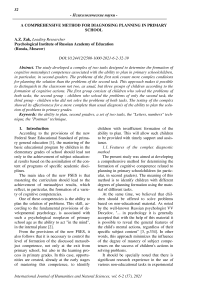A comprehensive method for diagnosing planning in primary school
Автор: Zak A.Z.
Журнал: Международный журнал гуманитарных и естественных наук @intjournal
Рубрика: Психологические науки
Статья в выпуске: 6-2 (57), 2021 года.
Бесплатный доступ
The study developed a complex of two tasks designed to determine the formation of cognitive metasubject competence associated with the ability to plan in primary schoolchildren, in particular, in second-graders. The problems of the first task create more complex conditions for planning the solution than the problems of the second task. This approach makes it possible to distinguish in the classroom not two, as usual, but three groups of children according to the formation of cognitive actions. The first group consists of children who solved the problems of both tasks, the second group - children who solved the problems of only the second task, the third group - children who did not solve the problems of both tasks. The testing of the complex showed its effectiveness for a more complete than usual diagnosis of the ability to plan the solution of problems in primary grades.
Ability to plan, second graders, a set of two tasks, the "letters, numbers" technique, the "postman" technique
Короткий адрес: https://sciup.org/170191002
IDR: 170191002 | DOI: 10.24412/2500-1000-2021-6-2-32-39
Список литературы A comprehensive method for diagnosing planning in primary school
- Federal state educational standard of primary general education. 2nd ed. Moscow: Prosvechenie, 2011. 41 p. [in Russian].
- Age and educational psychology / ed. A. V. Petrovsky. Moscow: Education, 1979. 287 p. [in Russian].
- Davydov V.V. Theory of developing education. M.: Intor, 1996.476 p. [in Russian].
- Fedekin I.N. A new method for diagnosing the formation of a planning action // Bulletin of the International Association "Developing Education", 2000, no. 7. pp. 127 - 139. [in Russian].
- Isaev, E.I. Psychological characteristics of planning methods in younger schoolchildren // Questions of psychology, 2014, no. 2. pp. 52 - 60. [in Russian].


